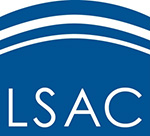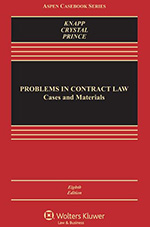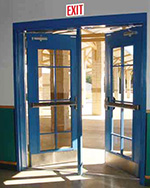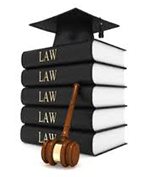 A lawyer, also called an attorney, is a person that has completed an undergraduate Bachelors degree in any subject, a Juris Doctor degree from a school accredited by the American Bar Association, passed a state’s bar exam, and filled out some paperwork with the state bar (officially called “getting licensed”). That’s it. That’s all a lawyer is. In some states, like California, a college degree isn’t required to become a lawyer. Many people in the United States are intimidated by lawyers. And indeed a great many lawyers use their perceived position of authority to attempt to intimidate and even threaten non-attorneys. But really nobody should ever be afraid or intimidated by an attorney. I can officially say that having attended three law schools and graduated from law school. While doing that, I saw people that could barely speak English that were able to graduate and pass the Texas bar exam. This post about law school is one of two posts I intend to write about the legal system in the United States. The other will be about the U.S. legal system in general. My goal with this blog post is to eliminate the mystique and misunderstanding about how attorneys come to be in the United States: what law school is, where law school isn’t required, the Law School Admission Test (LSAT), applying to law schools (the Law School Admission Council), what happens in law school (including between first year and second year), the required never-mentioned Multistate Professional Responsibility Exam (MPRE), bar prep programs, and details about the infamous (and not all that difficult) “bar exam”.
A lawyer, also called an attorney, is a person that has completed an undergraduate Bachelors degree in any subject, a Juris Doctor degree from a school accredited by the American Bar Association, passed a state’s bar exam, and filled out some paperwork with the state bar (officially called “getting licensed”). That’s it. That’s all a lawyer is. In some states, like California, a college degree isn’t required to become a lawyer. Many people in the United States are intimidated by lawyers. And indeed a great many lawyers use their perceived position of authority to attempt to intimidate and even threaten non-attorneys. But really nobody should ever be afraid or intimidated by an attorney. I can officially say that having attended three law schools and graduated from law school. While doing that, I saw people that could barely speak English that were able to graduate and pass the Texas bar exam. This post about law school is one of two posts I intend to write about the legal system in the United States. The other will be about the U.S. legal system in general. My goal with this blog post is to eliminate the mystique and misunderstanding about how attorneys come to be in the United States: what law school is, where law school isn’t required, the Law School Admission Test (LSAT), applying to law schools (the Law School Admission Council), what happens in law school (including between first year and second year), the required never-mentioned Multistate Professional Responsibility Exam (MPRE), bar prep programs, and details about the infamous (and not all that difficult) “bar exam”.
What Is “Law School”
 Most states are like Texas, where I went to law school full-time for three years to earn my Juris Doctor law degree. In most states, the state has it written in their state laws that a person is required to have earned a Juris Doctor from a law school accredited by the American Bar Association (“ABA-accredited”) to take that state’s bar exam.
Most states are like Texas, where I went to law school full-time for three years to earn my Juris Doctor law degree. In most states, the state has it written in their state laws that a person is required to have earned a Juris Doctor from a law school accredited by the American Bar Association (“ABA-accredited”) to take that state’s bar exam.
The American Bar Association has standards that law schools must follow to receive, and maintain, their accreditation. One of the ABA’s standards is that all coursework completed towards earning a Juris Doctor be completed in person. No online coursework or online degrees. That prevents dishonesty. Another ABA standard is that each law school maintain a certain minimum first-time bar passage rate for its graduates. That ensures that the school offer a law program that will adequately prepare students to pass the state’s bar exam the first time they take it after finishing law school.
Every law school offers a program for at least a Juris Doctor, which is a doctorate degree. Some law schools also offer a post-doctorate Master of Laws (called an “LL.M.”) for specialized types of law, like intellectual property, corporate governance, and federal taxation. State laws also usually permit persons that earned a Juris Doctor (“J.D. degree”) at a school outside of the United States to sit for the state’s bar exam. However, that almost always requires the person also complete at least one year of law school within the United States at an ABA-accredited law school. For that reason, many law schools offer a one-year LL.M. only for students that earned their J.D. degree outside of the U.S. so they can meet that requirement.
Where Law School Isn’t Required
 California is one of just four states that permits taking the state bar exam without a law degree. In fact, in California would-be lawyers don’t even need a Bachelors degree to take the bar exam. They just need to earn sixty credits towards an undergraduate degree, effectively an Associates degree from a community college. Although law school isn’t required, the would-be lawyer must first complete a four-year apprenticeship with a supervising attorney. Other states that offer similar alternatives to law school are Virginia, Vermont, and Washington.
California is one of just four states that permits taking the state bar exam without a law degree. In fact, in California would-be lawyers don’t even need a Bachelors degree to take the bar exam. They just need to earn sixty credits towards an undergraduate degree, effectively an Associates degree from a community college. Although law school isn’t required, the would-be lawyer must first complete a four-year apprenticeship with a supervising attorney. Other states that offer similar alternatives to law school are Virginia, Vermont, and Washington.
Law School Admission Test
 The Law School Admission Council (LSAC) is the organization that administers the nationwide Law School Admission Test (LSAT). An LSAT score is a requirement, and big factor, in law school applications. The LSAT is rather straight-forward and consists of five multiple-choice sections. Those sections include, in any order, three sections on verbal skills and reading comprehension, a section of constraint problems (also called “logic games”), and a fifth section that is an ungraded section of experimental questions that is the same as one of the other four sections. There is also an ungraded sixth section that ask for a “writing sample”, which a law school may request to review along with the LSAT score when considering a law school application. The best advice I have for anybody considering taking the LSAT is to take it more than once. Most people get a significantly higher score on the second attempt. Also, practice for the LSAT with real LSAT exams. LSAC publishes entire books of real previously-administered LSAT exams.
The Law School Admission Council (LSAC) is the organization that administers the nationwide Law School Admission Test (LSAT). An LSAT score is a requirement, and big factor, in law school applications. The LSAT is rather straight-forward and consists of five multiple-choice sections. Those sections include, in any order, three sections on verbal skills and reading comprehension, a section of constraint problems (also called “logic games”), and a fifth section that is an ungraded section of experimental questions that is the same as one of the other four sections. There is also an ungraded sixth section that ask for a “writing sample”, which a law school may request to review along with the LSAT score when considering a law school application. The best advice I have for anybody considering taking the LSAT is to take it more than once. Most people get a significantly higher score on the second attempt. Also, practice for the LSAT with real LSAT exams. LSAC publishes entire books of real previously-administered LSAT exams.
Applying to Law Schools (the Law School Admission Council)

Every law school sets its own standards for admission and reviews its own law school applications. However, every law school also requires applying through the previously mentioned Law School Admission Council (LSAC). Applicants don’t apply directly to law schools. Instead, applicants submit all of their credentials to LSAC, which keeps a single file for each applicant. Those credentials include a single application that is completed once by the applicant, LSAT scores, official school transcripts, criminal records, and letters of recommendations. When applying to a law school, the applicant merely requests their already-completed application and supporting documents all be forwarded electronically to the school.
American Bar Association rules require the completion of a Bachelors degree, in any subject, from an accredited university, prior to enrollment in law school. It’s worth noting, though, that it wasn’t always that way. Up until the 1970’s, it was possible in the United States to earn a Bachelor of Laws. A person could get an undergraduate degree in law and qualify to take a state’s bar exam. This certainly saved students a lot of tuition money. However, the result was attorneys that knew little about the law and almost nothing about any other professional subject. To try and fix this, the American Bar Association created the requirement of a Bachelors degree prior to law school and established the Juris Doctor as a graduate degree. The goals were more competent newly-licensed attorneys and furtherance of the legal profession, with lawyers (hypothetically) having unrelated professional skill from their undergraduate degree that they can combine with their legal education.
Criminal history is also obviously an important part of any law school application. Most states won’t allow a person that has been convicted of a felony within the last ten years to enroll in law school. All applications to law school are required to include a copy of every arrest report (whether or not convicted), criminal court conviction (if any), and explanation for the offense written by the applicant. These documents are all necessary a second time when the first-year law student submits their Declaration of Intent to Study Law to the state bar. Some states, like Texas, have a “State Board of Law Examiners” responsible for all applications to become an attorney in that state. In those states, the Declaration of Intent to Study Law, like all other documentation to become an attorney, is provided to the state board of law examiners instead of the state bar.
First Year of Law School (1L)
 After being accepted by a law school, the next big step is a week-long orientation with prominent speakers from the local legal community, school deans and administration, and professors. Students are also sorted by the law school into one of four sections. The incoming class at most law schools for first year law students is approximately 240 students, which is divided into four sections of 60 students each. The reason for dividing students into sections is primarily that all first-year students (called “1L’s”) have the same curriculum. Dividing the students into four sections means there is only four schedules. First-year students have no choice in their courses, schedule, or professors. First-year students also have the same people in all their classes. Despite initially thinking that they will develop some comradery with these people, once each student realizes there is a grading curve, by the end of their first year of law school everybody is sick of everybody else in their section and would be perfectly content never to see most of them ever again.
After being accepted by a law school, the next big step is a week-long orientation with prominent speakers from the local legal community, school deans and administration, and professors. Students are also sorted by the law school into one of four sections. The incoming class at most law schools for first year law students is approximately 240 students, which is divided into four sections of 60 students each. The reason for dividing students into sections is primarily that all first-year students (called “1L’s”) have the same curriculum. Dividing the students into four sections means there is only four schedules. First-year students have no choice in their courses, schedule, or professors. First-year students also have the same people in all their classes. Despite initially thinking that they will develop some comradery with these people, once each student realizes there is a grading curve, by the end of their first year of law school everybody is sick of everybody else in their section and would be perfectly content never to see most of them ever again.
The first year curriculum is the same at every law school, mostly including the textbooks. First-year students take all of the following: Contracts, Real Property, Torts, Criminal Law, Federal Civil Procedure, Constitutional Law, Legal Writing, and Legal Research. Most law schools only test each subject, including the 1L courses, using essay questions. However, paradoxically, the materials learned during 1L are only really tested on bar exams on the one-day MBE section (Multistate Bar Exam), which is entirely multiple-choice questions. More details about the MBE, and bar exam, later in this post.
Textbooks in law school are almost entirely just “casebooks”. A casebook is a book of court opinions that are important to teach the concepts for a given topic. For example, the casebook for contracts class is just a collection of court opinions that demonstrate the important contracts concepts. Those concepts include, among other things, whether there was an offer, acceptance of an offer, breach of contract, and whether a contract was enforceable.
Students learn during 1L that law school is mostly just reading cases in casebooks and writing briefs. Most law school courses consist of nothing more than just reading, and briefing, one-by-one, every case in a casebook. A brief is just a one-page summary of a case. A brief consists of the case name and four-paragraph “IRAC” writing format: case issue (Issue), rule of law used in the case (Rule), application of the law to the facts (Application), and the court’s conclusion in the case (Conclusion). Contrary to popular belief, none of the work in law school is particularly difficult. There are graduate programs that are much more difficult, like medicine. Law school is, however, very demanding on the student’s time. It’s lots of reading cases and writing briefs. Law school isn’t difficult, just demanding.
Getting called on by a professor “to recite” is a big deal, but mostly only in the first year of law school. Reciting means that a professor calls on a student at random during class to ask them everything the professor can think of about a case. The student is required to stand up when called on, which means if they didn’t read the case or prepare a brief then they get to look like an idiot in front of all their classmates. Some professors won’t let students open their casebook (or laptop or smartphone) during class. So if they didn’t read the case or write a brief, then they’re screwed. I had one professor that if he called on a student to recite and they weren’t prepared, then he’d ask them to leave the classroom for the remainder of class. His point was that if you’re going to show up unprepared then don’t bother showing up at all. I made sure to always be prepared for his class and he was actually one of my favorite professors.
Also during the first year of law school, students are required to submit a “Declaration of Intent to Study Law” to their state bar or state board of law examiners. Unlike any other graduate programs (that I know of), students must get permission from the state to enroll in law school. The Declaration of Intent to Study Law includes a comprehensive “moral and character fitness” review. The moral and character fitness review requires, in the Declaration of Intent, a list of every address/city/state where the applicant has lived in the past ten years, list of every employer in the last ten years, list of every college-level school ever attended, list of any lawsuits the applicant was ever involved in, and the contact information for at least five personal references. The review also requires copies of every arrest report (whether or not convicted), criminal court conviction (if any), and explanation for the offense written by the applicant. The review also requires going to a special location to get digitally fingerprinted and submitting to separate background checks by both the FBI and Department of Justice.
Second Year of Law School (Curving Out, Dropping Out, and Transferring) (2L)
 Most law students remain in the same school where they attended their first year of law school. However, when students go back for their second year, over time they notice that many 1L classmates are gone. They either curved out, dropped out, or were secretly filling out transfer applications that they didn’t mention at all to any of their classmates. Before describing the second year of law school (“2L”), I will briefly discuss these three events that may occur between 1L and 2L.
Most law students remain in the same school where they attended their first year of law school. However, when students go back for their second year, over time they notice that many 1L classmates are gone. They either curved out, dropped out, or were secretly filling out transfer applications that they didn’t mention at all to any of their classmates. Before describing the second year of law school (“2L”), I will briefly discuss these three events that may occur between 1L and 2L.
“Curving out” is something that happens automatically at many law schools. After all the first-year grades have been submitted by the professors, the law school assigns each student their class rank among their 1L classmates. If a student is not above a certain class rank, say for example in the top two-thirds, then the student is below the curve to remain in law school and the school tells them that they can’t go back. The student is effectively thrown out of law school. However, some schools allow the curved out students to re-attempt their first year of law school (at the student’s expense) after waiting a year.
Other students drop out of law school. They simply decide between 1L and 2L that law school isn’t for them. Many law schools students went to law school because they didn’t want to work after getting their undergraduate degree and thought a different graduate program would be more difficult. However, those students sometimes find that they are bored with law school and pursuing a law degree isn’t a good personal fit. Therefore, they drop out of law school.
Some students transfer to a different law school. Between the first year and second year is the only time a student may transfer law schools, according to the rules of the American Bar Association. Wherever a student “commences” their second year must be the school where they earn their Juris Doctor. ABA rules also establish that, for statistical purposes, only the incoming first-year students are used to establish the demographics of each law school’s students. Those demographics include range of student grade point average (gpa), range of LSAT scores, gender, race, and age. Law schools rarely, if ever, look at LSAT scores or undergraduate grades when considering transfer applications. Because law schools are more lenient in admitting transfer student for 2L, a high class rank during 1L, along with good letters of recommendations from first-year professors, is often a student’s ticket to trade up to a better (or different) law school.
Wherever a student goes for their second year of law school, they find out that it’s just more of the same (casebooks and briefs), except there are mostly no required courses like 1L and no sections with the same classmates. Students get to set their own schedule, both the courses they take and the professors for those courses (if offered by more than one professor). Some schools do require a few courses, like Professional Responsibility. Most law students, by choice, choose to take the classes during 2L and 3L for subjects tested on most state bar exams. Those courses include: Evidence, Family Law, Community Property, State-Specific Real Property Law, Criminal Procedure, Oil & Gas (Mineral) Law, Consumer Rights, Business Organizations, Commercial Law, and Wills & Trusts.
There’s a debate among law students as to whether they should devote their law school curriculum to taking all the classes to prepare them for the bar exam versus taking electives that are not tested on the bar exam. I felt strongly about one approach before law school and the opposite after law school. I’ll get to explaining “Bar Exam Courses versus Electives” in a moment.
Third-Year of Law School (3L)
 “First year, they scare you to death. Second year, they work you to death. Third year, they just plain bore you to death.” That’s a popular saying among former law students. And it’s true. During the first-year, everybody tries to convince the first-year students that law school is incredibly difficult and impossible to finish. During the second year, it’s just a lot more of what is learned during 1L, more cases to read and more briefs to write. By third-year, law students are just plain bored and ready to be done with it all. Third-year law students seldom see each other, usually because they are doing an externship or working on career plans for after graduation.
“First year, they scare you to death. Second year, they work you to death. Third year, they just plain bore you to death.” That’s a popular saying among former law students. And it’s true. During the first-year, everybody tries to convince the first-year students that law school is incredibly difficult and impossible to finish. During the second year, it’s just a lot more of what is learned during 1L, more cases to read and more briefs to write. By third-year, law students are just plain bored and ready to be done with it all. Third-year law students seldom see each other, usually because they are doing an externship or working on career plans for after graduation.
Adjunct professors are sometimes an option for third year, and second year, law students. Adjunct professors (“adjuncts”) are part-time professors that show up at the law school to teach just one class per week. They are full-time attorneys with real jobs at real law firms or work at various government agencies (like the county prosecutor’s office, public defender’s office, or even as judges). Per ABA rules, full-time law professors are not permitted to practice law while working as a full-time professor. Many full-time law professors are not licensed attorneys. Unlike full-time professors, adjuncts can explain how the practice of law actually works in the real world, like what a trial court judge will probably do in a given situation regardless of what the law says the judge must do or what would be effective in front of a jury. Adjuncts are also great networking opportunities for law students, because adjuncts already have jobs in the real world. Be sure to take an adjunct up on any offer to visit them at their office and meet other legal professionals. Whenever possible, I wholeheartedly encourage law students to take courses taught by adjunct professors.
Attending a second law school as a visiting student is also an option for third year, and second year, law students. ABA rules allow a student to take classes at two law schools at the same time, provided the student gets permission from their home school (the school where they will graduate from), the student is admitted into the second school as a visiting student, and the courses taken at the visiting school are not offered at the home school. Students interested in international law use the visiting student option to do a “semester abroad” in a foreign country. Other visiting students take courses in a location popular for the type of law they want to practice, like Silicon Valley for venture capital or Los Angeles for entertainment law.
The experience of being a visiting student at a second law school is well worth it, even if for no other reason than the perspective you gain about both of the schools, the students, and law school in general. I personally did a semester as a visiting student at a law school to specialize in corporate transactional practice. That program consisted of a semester-long simulated reverse triangular merger using a leveraged buyout (no casebooks or briefs), and was taught by three practicing attorneys that specialize in mergers and acquisitions. My visiting student program also included courses in construction law and antitrust law. Another program I did at the same time involved two courses devoted to music industry contracts and entertainment law, taught by a prominent adjunct attorney that specializes in artist representation for musicians and entertainers.
Law clinics are an interesting thing available to third-year students at most law schools, and they provide a way to get a temporary law license from the state without taking the bar exam. A “law clinic” is effectively a law office suite setup inside an office suite at the law school. The clinics work on real cases that are typically referred to them by departments of the local county government, often for low-income clients. The types of cases that law school clinics work on include Probate Law (settling the estate of people that recently died), Family Law (custody and child support), and Criminal Law (misdemeanor criminal offenses). A law professor, that is also a licensed attorney, serves as a supervising attorney for law students that work in the clinic. The law students, with their temporary law license, get the experience of actually practicing law, working directly with real clients, and going to court appearances and court-ordered mediations. I worked in a law clinic for probate legal matters when I was in law school. We also handled cases involving adult guardianships and subsidized housing for low-income families. The work was rewarding and I am proud of what I accomplished for my clients.
Bar Exam Courses versus Electives
 I felt strongly before going to law school, and during 1L, that it would be a waste of time to go to law school, not take all of the courses for the subjects tested on the bar exam, graduate, and then not be able to pass the bar exam, get licensed as an attorney, or practice law. When I got to 2L, and could start to see beyond law school, my conclusion was the complete opposite.
I felt strongly before going to law school, and during 1L, that it would be a waste of time to go to law school, not take all of the courses for the subjects tested on the bar exam, graduate, and then not be able to pass the bar exam, get licensed as an attorney, or practice law. When I got to 2L, and could start to see beyond law school, my conclusion was the complete opposite.
Taking law school courses just to prepare for the bar exam itself is a waste of tuition money. Every law school offers courses for the subjects tested on their state’s bar exam (the “bar subjects”). Some law schools offer not just the bar subjects, but also classes to prepare students for the bar exam itself. For example, entire classes specifically to study the Multistate Bar Exam, Multistate Performance Test, and Bar Essay Writing. A student can spend an entire semester’s worth of tuition taking law school courses just to prepare for the bar exam. But knowing how to pass the bar exam won’t do the person any good after they pass the bar exam. It’s not worth wasting an entire semester of law school just to be able to pass the bar exam on the first attempt.
Taking only bar subject courses during law school also means sacrificing any unique legal skills that would make the would-be lawyer more competitive than anybody else that recently graduated law school. As a law student gets closer to graduating, it becomes clear that beyond graduation the person will need skills that make them stand out professionally. Some of those skills can be attained during an undergraduate education. However, the only real opportunity to gain skills specific to a legal career is during law school itself.
Simply put: A person can retake the bar exam. They cannot retake law school. Passing the bar exam on the first attempt is meaningless. Nobody cares. My advice to law students is to use your law school experience to learn skills applicable to the specific type of law, or types of law, you want to practice. My advice is also to take just courses for the subjects on the bar exam that you think will be the most challenging for you. The rest of those subjects tested on the bar exam either don’t need to be learned at all (as explained below in the section about the bar exam) or can be learned in a bar prep program during the two months between graduating law school and taking the bar exam.
Multistate Professional Responsibility Exam (MPRE)
 The Multistate Professional Responsibility Exam (“MPRE”) is a test every would-be lawyer must take in addition to the bar exam. A passing score (typically 36 of the 60 questions) must be provided to the state bar, or state board of law examiners, along with a passing score on the bar exam itself, in order to get licensed as an attorney. The MPRE is 60 multiple-choice questions about what a lawyer should do in various ethical situations. Those situations include protecting a client’s privileged information, keeping client money separate from the attorney’s own money, what to do when knowing another attorney (or a judge) has done something unethical or illegal, and when to recognize conflicts-of-interest. The MPRE is not a big deal, but it’s worth knowing about because every state requires a passing score on it to get licensed. Most students take the MPRE during their second-year or third-year of law school. Many law schools require students take a course during 2L called Professional Responsibility to prepare them for the MPRE.
The Multistate Professional Responsibility Exam (“MPRE”) is a test every would-be lawyer must take in addition to the bar exam. A passing score (typically 36 of the 60 questions) must be provided to the state bar, or state board of law examiners, along with a passing score on the bar exam itself, in order to get licensed as an attorney. The MPRE is 60 multiple-choice questions about what a lawyer should do in various ethical situations. Those situations include protecting a client’s privileged information, keeping client money separate from the attorney’s own money, what to do when knowing another attorney (or a judge) has done something unethical or illegal, and when to recognize conflicts-of-interest. The MPRE is not a big deal, but it’s worth knowing about because every state requires a passing score on it to get licensed. Most students take the MPRE during their second-year or third-year of law school. Many law schools require students take a course during 2L called Professional Responsibility to prepare them for the MPRE.
Bar Prep Programs
 Bar prep programs are actually worth it. Most people can almost learn everything they need to know for the bar exam in these two-month programs. They prepare students for the multiple-choice multistate bar exam (MBE), multistate performance test (MPT), essay section of the bar exam, and any state-specific requirement of the bar exam. Bar prep programs refresh a student’s memory of concepts they may have forgotten over three years of law school. The programs include complete outlines for each subject, organized in a format specifically to study for the bar exam. They also educate would-be test-takers on the most heavily tested topics within each subject. For example, Individual Rights is a heavily tested topic in questions about Constitutional Law. Bar prep programs include practice exams and grading of sample essay questions by real people that provide real feedback.
Bar prep programs are actually worth it. Most people can almost learn everything they need to know for the bar exam in these two-month programs. They prepare students for the multiple-choice multistate bar exam (MBE), multistate performance test (MPT), essay section of the bar exam, and any state-specific requirement of the bar exam. Bar prep programs refresh a student’s memory of concepts they may have forgotten over three years of law school. The programs include complete outlines for each subject, organized in a format specifically to study for the bar exam. They also educate would-be test-takers on the most heavily tested topics within each subject. For example, Individual Rights is a heavily tested topic in questions about Constitutional Law. Bar prep programs include practice exams and grading of sample essay questions by real people that provide real feedback.
I did the Texas bar prep program offered by Kaplan Bar Review, and about to start Kaplan’s program for California and then Delaware. My law school was willing to pay for Kaplan’s Texas program so I didn’t really look at anything else. However, I was very satisfied with Kaplan’s bar prep program, the materials provided (books, videos, and iPhone app), and also with Kaplan’s customer support. Kaplan’s pricing also included half-off to take the bar prep program for another state. Since my law school paid for the Texas program, that meant I qualified to take the two-month California bar prep program basically for free.
National Conference of Bar Examiners (A Non-Profit Organization)
![]() A company called the National Conference of Bar Examiners (“NCBE”) writes the Multistate Bar Exam (MBE), Multistate Performance Test (MPT), Uniform Bar Exam (UBE), and previously-mentioned Multistate Professional Responsibility Exam (MPRE). NCBE also writes the Multistate Essay Exam (MEE), which is part of the Uniform Bar Exam. Every state uses the MBE as part of its bar exam. Most states also use the MPT as part of their bar exam. Many states use the UBE as their entire bar exam, which includes the MBE, MPT, and MEE. Everybody that takes an NCBE exam has an NCBE file number.
A company called the National Conference of Bar Examiners (“NCBE”) writes the Multistate Bar Exam (MBE), Multistate Performance Test (MPT), Uniform Bar Exam (UBE), and previously-mentioned Multistate Professional Responsibility Exam (MPRE). NCBE also writes the Multistate Essay Exam (MEE), which is part of the Uniform Bar Exam. Every state uses the MBE as part of its bar exam. Most states also use the MPT as part of their bar exam. Many states use the UBE as their entire bar exam, which includes the MBE, MPT, and MEE. Everybody that takes an NCBE exam has an NCBE file number.
NCBE allows states to retain their test-taker scores with NCBE for the MPRE, MBE, and UBE. Some states offer this to their test-takers to allow “score portability” of MPRE, MBE, and UBE scores. The purpose is to allow a test-taker to use a score received in one state to apply that score to another state instead of taking the exam a second time.
The Infamous “Bar Exam” (What It Is)
 “The bar exam” is an exam that is administered by the state bar or state board of law examiners, not the law schools. There is no standardized national bar exam, although the Uniform Bar Exam (UBE) is becoming close to effectively being that. By the time law students graduate and take a state’s bar exam, after hearing about it non-stop for three years, the bar exam has developed a bizarre mystique and mythical quality. But really, the bar exam is just two days of standardized testing. And one of those two days is only multiple-choice questions. California makes its past bar exams, including the best correct answers, publicly available online. So does Texas, including the best correct answers.
“The bar exam” is an exam that is administered by the state bar or state board of law examiners, not the law schools. There is no standardized national bar exam, although the Uniform Bar Exam (UBE) is becoming close to effectively being that. By the time law students graduate and take a state’s bar exam, after hearing about it non-stop for three years, the bar exam has developed a bizarre mystique and mythical quality. But really, the bar exam is just two days of standardized testing. And one of those two days is only multiple-choice questions. California makes its past bar exams, including the best correct answers, publicly available online. So does Texas, including the best correct answers.
Most, if not all, states only administer the bar exam in July and February. The July bar exam is taken by far more people than the February exam, and administered everywhere in the state that there is a law school. The July bar exam is so popular because the overwhelming majority of law students graduate from law school in May. Everybody that just graduated law school in May wants to take the bar exam in July while the material is still fresh in their mind. The February bar exam is only offered in one location per state. The February bar exam is mostly taken by repeat test-takers and out-of-state attorneys attempting to get licensed in another state.
Every state uses the Multistate Bar Exam (MBE), which is two hundred multiple-choice questions, and itself is one of the two days of the bar exam. One hundred questions are administered in a three-hour morning session. The other one hundred questions are administered in a three-hour afternoon session. Every question is its own paragraph about a fact situation followed by four answer choices. Unlike regular multiple-choice tests, where some of the answer choices can be easily eliminated as wrong, law school multiple-choice tests (including the MBE) are comprised of four answer choices that are all correct. Getting the question right requires choosing the answer choice that is most correct, which can be tricky. MBE tests the following law subjects: Contracts, Real Property, Torts, Constitutional Law, Federal Rules of Evidence, Criminal Law / Criminal Procedure, and Federal Civil Procedure.
Most states use the Multistate Performance Test (MPT), which is similar to an essay, except the test-taker is asked to prepare a specific type of legal document on behalf of a pretend law firm in a pretend lawsuit or criminal case. The MPT is administered for ninety minutes and consists of two booklets: a “file” that contains various legal documents in the pretend case at the pretend law firm, and a “library” that contains written versions of pretend laws and pretend case opinions. The type of document the test-taker is asked to write could be either a letter to the client, memorandum to a supervising attorney, or motion to the court for a judgment in the case. The MPT is graded based on “points” given for various concepts, like the test-taker’s skill in recognizing the relevant facts, application of the law provided to the facts, and the ability to complete all the writing tasks within the time limit of just ninety minutes. Some states, like those that use the Uniform Bar Exam, require test-takers to take two MPT exams during the bar exam, with each MPT exam lasting ninety minutes.
Many states differ as to the essay portion of the bar exam. Approximately forty states use the Multistate Essay Exam (MEE), which consists of six essay questions that are each thirty minutes. Those states that use the Uniform Bar Exam use the MEE. California uses its own essay portion of the bar exam, consisting of five thirty-minute essays. Texas also uses its own essay portion of the bar exam, consisting of twelve thirty-minute essay questions. In every state, each question of the essay portion of the bar exam consists of a half-page of facts (the “fact pattern”) followed by a series of questions that require the test-taker to make a legal conclusion about the facts and provide a legal analysis explaining their answer. Points are earned on the essay section by giving the “correct” answer, the amount of details provided in the test-taker’s explanation and legal reasoning of their answer, and proper use of all legal terminology. In every state, including those that use the Multistate Essay Exam and Uniform Bar Exam, the bar exam essay answers submitted by test-takers are graded by examiners within the state (not the NCBE company that writes the questions).
The subjects tested on the essay portion of all state bar exams are almost all the same. Those subjects include Business Organizations (agency, partnerships, and corporations), Commercial Law (Uniform Commerce Code), Consumer Rights, State-Specific Real Property, Family Law, Community Property, Guardianships, Wills, and Trusts. The essay questions sometimes also include “cross-over” topics that can be written about in the answers for additional potential points. Those cross-over topics include details about such subjects as Evidence, Civil Procedure, Professional Ethics, and Taxation.
The Uniform Bar Exam, as I’ve mentioned a few times, is increasingly becoming the “standard” bar exam. In my opinion, having studied for three separate state bar exams (Texas, California, Delaware), adopting the Uniform Bar Exam in every state would be for the best. State-specific bar exams force students to take state-specific classes that make it more difficult to become a lawyer in another state. State-specific bar exams also force students to commit to taking a state-specific bar prep program. That’s very expensive for most law students, both the law school tuition costs and expense of a bar prep program. Many students also attend law school out-of-state, where taking state-specific classes to prepare for the bar exam is not an option. California does not use the Uniform Bar Exam. Texas just recently completely eliminated its Texas Bar Exam and adopted the Uniform Bar Exam.
Grading Of The Bar Exam
The bar exam in every state uses a point system that requires the test-taker earn a minimum number of points on the entire test in order to pass the bar exam. The bar exam is either pass or fail. Nobody cares at all by how much somebody passed the bar exam. Grading on every portion of the bar exam is on a scaled score. That means that, instead of receiving a raw score, the points are statistically adjusted to compensate for various factors like questions that most people got wrong (and shouldn’t count at all) and the overall number of total points that most people earned on a given section (and should therefore count as the middle of the grading curve).
In most states, from what I understand, professors at the law schools within the state volunteer to grade the essay answers. The essay graders are only provided the anonymous examinee number, not the test-taker’s actual name. The state bar, or board of law examiners, mails to the essay graders entire boxes full of printed copies of all the test-taker essay answers. The essay graders then read each test-taker’s answers, provide points to each answer based on various factors, and then mail the graded essays to the state bar (or board of law examiners) to include in their calculation of the test-taker’s final score on the bar exam.
Experience Of Taking The Bar Exam
The bar exam in every state is administered over two days, the last Tuesday and Wednesday of July/February. Both days consist of a three-hour morning session, hour for lunch (and more studying), and a three-hour afternoon session. The bar exam is administered in a convention center, where each test-taker sits at an assigned seat at a folding table. The convention center space is just a big open space with long rows of folding tables and an examinee number taped to where a person’s assigned seat is located. There is a row of tables in front that face the test-takers so examiners can monitor the test-takers. Examiners also walk among the test-takers throughout the test. Attire is casual. Test-takers wear t-shirts, jeans, shorts, sandals, even flip-flops. Whatever a test-taker wears each day to the bar exam should be something they will be comfortable wearing for an entire day while they sit and and focus on taking the exam.
When a person registers for a state’s bar exam, they are provided an admission ticket to print out that has their name and examinee number. When entering the convention center, the test-taker shows their admission ticket and state-issued identification card to a person at the door and then proceeds to wherever the assigned seat is located for their examinee number. The test-taker is required to place their admission ticket and state-issued identification card in front of them on the table for the duration of the test. Test-takers may bring their own laptop on the day of the essay questions to write their essay answers using their laptop and special software. The special software closes every other program on the laptop and disables all the networking (including Wi-Fi). Only after the test is over may test-takers use the software to re-enable their Wi-Fi and upload their essay answers to the state’s website for grading. Test-takers may not bring their laptop, or anything else besides pencils, on the day of the bar exam for the MBE (multiple-choice test).
Taking the bar exam is just a formality. The test-taker is just repeating over two days the same concepts they spent reading over and over for the last three years. If the test-taker attended a bar prep program, then that person also spent two full months studying all day every day just for the bar exam leading right up until taking the bar exam itself. It’s not worth stressing out over at all. And like I said, half of it is just multiple-choice questions. Everybody I know that has ever taken a state bar exam (literally hundreds) asked themself the same question after it was over: That’s really all it is?
Bar Exam Results & Getting Licensed As An Attorney
 Results for the bar exam are released three months after the exam itself. Grading all of the essay answers submitted by hundreds of test-takers requires all that time. In the letter to each test-taker notifying them of their results, states just provide that person with their score and whether they passed or failed. Some states, like Texas, provide test-takers that didn’t pass with a detailed score report indicating the points they earned in each section, and on each individual legal subject tested, along with their percentile rank among other test-takers for the amount of points they earned for each tested legal subject.
Results for the bar exam are released three months after the exam itself. Grading all of the essay answers submitted by hundreds of test-takers requires all that time. In the letter to each test-taker notifying them of their results, states just provide that person with their score and whether they passed or failed. Some states, like Texas, provide test-takers that didn’t pass with a detailed score report indicating the points they earned in each section, and on each individual legal subject tested, along with their percentile rank among other test-takers for the amount of points they earned for each tested legal subject.
Test-takers that received a passing score on a state bar exam may then fill out, and submit, the application to get licensed as an attorney in that state. That application includes proof of the applicant’s passing scores on both the bar exam and MPRE. There is also another “moral and character fitness” review by the state bar. However, those applicants that have previously completed that state’s moral and character fitness review during law school merely fill out a form certifying to the state that nothing has changed (like a lawsuit or arrest) since the applicant previously completed the moral and character fitness review.
Once a person has been licensed as an attorney in one state, they may then proceed as an “out-of-state attorney” in a different state on a case-by-case basis by getting permission from the judge in that case. That is done by filing a motion in the out-of-state case, called a “motion for pro hac vice”. An attorney licensed in one state may also typically get licensed in subsequent states by taking a one-day “attorney’s examination” in that state. The one-day “attorney’s examination” is most states is just the essay portion of that state’s bar exam. Most states also won’t let an out-of-state attorney take its attorney’s examination unless the applicant has been licensed at least five years in the state where that person is already licensed as an attorney. Otherwise, the applicant must take the complete bar exam to get licensed.
The Legal System in the United States
 And that’s it. In the United States, that’s all there is to going to law school, taking the bar exam, and getting licensed as an attorney. There’s nothing mysterious or secretive or intimidating at all about lawyers or how lawyers become lawyers. I tried to limit myself in this writing to details that are applicable and relevant to everybody that seeks to become an attorney. At the same time, my goal in writing this was to explain the complete process from beginning to end, so that everybody can understand in plain English exactly what would-be lawyers go through to become lawyers. As I said at the beginning, this is one of two posts I plan to write about the legal system in the United States. My other post about the legal system in the U.S. will be about the legal profession itself, what lawyers do, how our court system is designed to function, and how our court system actually works.
And that’s it. In the United States, that’s all there is to going to law school, taking the bar exam, and getting licensed as an attorney. There’s nothing mysterious or secretive or intimidating at all about lawyers or how lawyers become lawyers. I tried to limit myself in this writing to details that are applicable and relevant to everybody that seeks to become an attorney. At the same time, my goal in writing this was to explain the complete process from beginning to end, so that everybody can understand in plain English exactly what would-be lawyers go through to become lawyers. As I said at the beginning, this is one of two posts I plan to write about the legal system in the United States. My other post about the legal system in the U.S. will be about the legal profession itself, what lawyers do, how our court system is designed to function, and how our court system actually works.
 Triumph of the Nerds: The Personal Computer
Triumph of the Nerds: The Personal Computer
 Prizeo Brings Together Celebrities And Charities To Increase Awareness And Raise Money
Prizeo Brings Together Celebrities And Charities To Increase Awareness And Raise Money
 Venture Deals Explains Modern Venture Capital
Venture Deals Explains Modern Venture Capital
 Five Years of Y Combinator Universe
Five Years of Y Combinator Universe





